
13 minute read
PENGUIN TRIVIA Our favourite penguin facts
TOP 10
PENGUIN FACTS
Fascinating and frequently funny, we’ve rounded up our ten favourite facts about the wildlife stars of Antarctica
LEAPING FOR JOY Like porpoises, penguins leap in shallow arcs above the surface of the water. When they do this, tiny bubbles cover their feathers which reduces friction when they swim. Leaping out of the water also helps them escape predators. But the general view is that, just like porpoises, penguins leap for joy.
DRINKING SALTY WATER Because most penguins live in places where there is little or no fresh water, and because they eat so much seafood, they need to expel the high amount of salt in their diet. They do this through a gland located just above their eye, which filters the salt from their bloodstream. The salt is then expelled through the bill, or by sneezing!
WHY WALK WHEN YOU CAN WADDLE? Penguins’ legs are not especially short, so why do they waddle? Scientists believe it is because their legs have evolved to help them swim better, and are now set further back on the body. is makes it harder for them to walk, and easier to waddle.
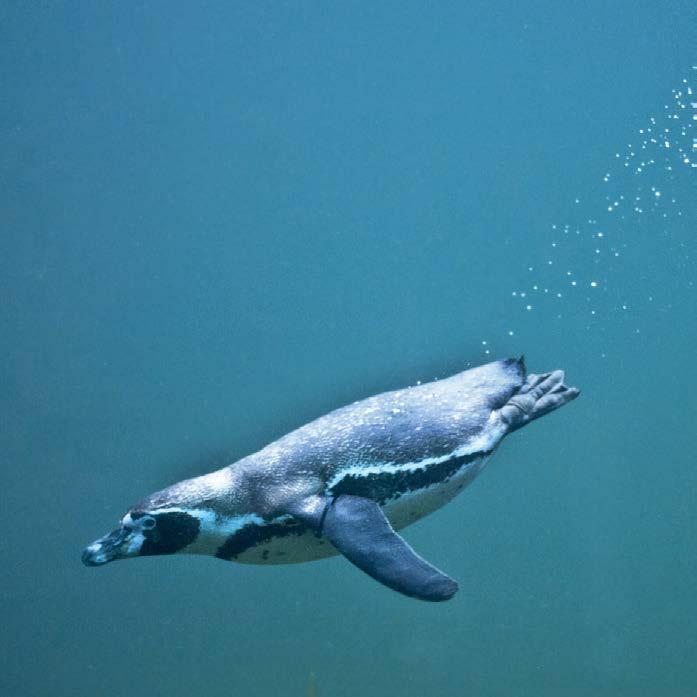
OLYMPIC SWIMMERS The world’s fastest underwater birds, Gentoo penguins can swim up to 20 miles per hour and dive to depths of over 600 feet. Penguins lost the ability to fly millions of years ago, but their wings evolved into flippers that help them zip through the water.
PENGUINS HAVE KNEES Yes, they do! You just can’t see them because they’re hidden under all their u y feathers.

6BLACK AND WHITE CAMOUFLAGE Male and female penguins both have the same tuxedo-like coloration, which helps protect them against predators in the water. It’s called countershading. The black plumage on their back makes it hard to see them from above. And the white plumage on their front, when seen from below, looks like the sun reflecting off the water.
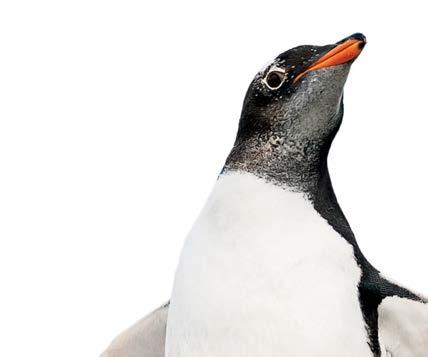


THE FREEZE FACTOR Life in the big freeze can be tough for these flightless birds, and they have cleverly evolved to survive the harsh conditions. To stop their feet from freezing, penguins have special arteries in their legs that can adjust blood flow in response to their foot temperature, enabling them to send just enough blood to their feet to keep them above freezing.
CATASTROPHIC MOULTING Penguin feathers are shorter and sti er than most bird feathers, making them more streamlined in the water. Unlike ying birds that moult slowly over time, penguins moult all their feathers over just a few weeks every summer. It’s called catastrophic moulting. During this time, they cannot enter the water, so they need to have stored enough fat to fast, until they can head back out to sea with a new coat.
UNDERWATER VISION Penguins have a secondary transparent eyelid to enable them to see underwater, meaning their vision is better underwater than on land. is ‘see-through’ eyelid helps them to see clearly as they swim underwater, giving them superior eyesight to spot prey while hunting. LET’S STICK TOGETHER Highly social birds, penguins form breeding colonies called rookeries, in which they live in the tens of thousands and even millions. Many penguins stay with the same mate for years, and families stick together, with many generations using the same nesting ground. Penguins’ excellent hearing helps them find each other in a crowd. 10


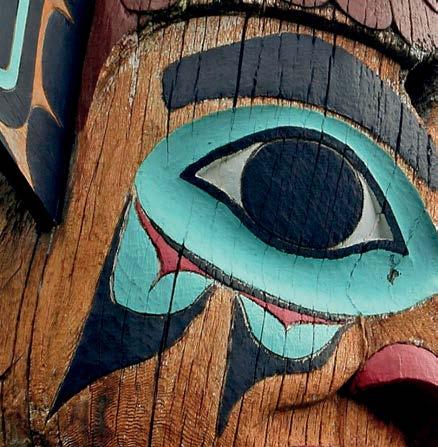
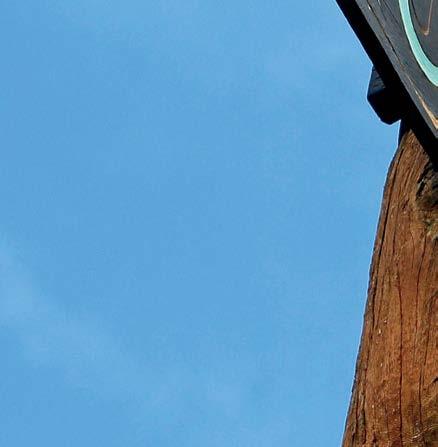
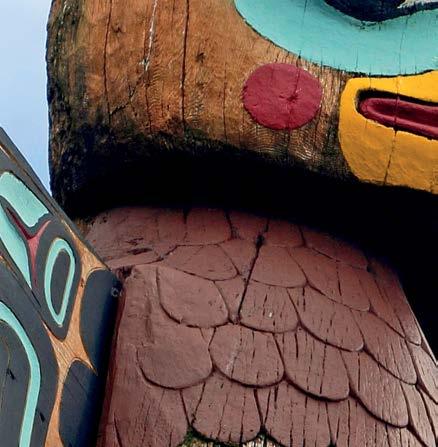



LEGEND
LORE
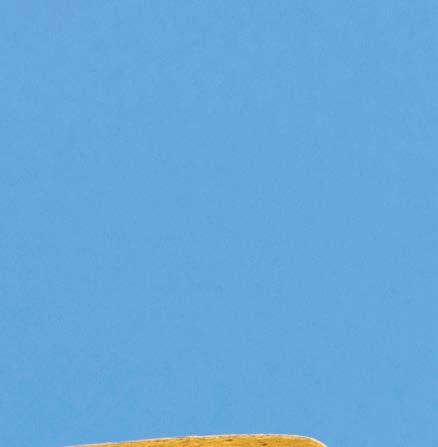




We delve into the history and meaning carved into the majestic totem poles of Alaska
This page: The incredible carved detail of a Tlingit totem pole at Saxman Totem Park in Alaska

The totem poles of Alaska, created by coastal First Nations and indigenous groups of the Paci c Northwest, in particular the Tlingit, Tsimshian and Haida communities, are magni cent pieces of art that conjure up memories of people and events.
Usually standing between three and 18 metres in height – although some can surpass 20 metres – poles were traditionally carved by men. Today, however, both men and women have become expert carvers of totem poles, often honing their skills after spending their childhood years watching experts in action. e word ‘totem’ can be traced to the Algonquian word odoodem, meaning “kinship group”. Typically

created out of red cedar wood, most totem poles feature symbolic animals or human forms, as well as supernatural beings that chart a family’s lineage and history.
Common crests include the thunderbird, wolf, grizzly bear, raven, beaver, frog, salmon and eagle, and important families often have more than one crest. In addition to family-related themes, totem poles can also be created to mark a special event or to commemorate a particular ancestor or legend. ey can also be used as a point of welcome, or as a sign of remembrance, and can be erected to celebrate a family’s success.
Embedded in the culture, the ability to appreciate the meaning carved into a speci c totem


FACTS AND FIGURES • Alaskan totem poles are carved from cedar trees, which are resistant to rot and grow in the rainforests of Southeast Alaska. • Standing at 132 feet tall, one of the tallest totem poles in the world is in Kake, Alaska. • Paint was traditionally made from a mix of chewed cedar bark and salmon eggs, along with powdered pigments, in order to create an oil-based paint. Today, synthetic paints are often used, but some carvers still use natural pigments derived from charcoal and ochre. • Early European explorers mistakenly believed totem poles to be objects of worship. • The Tlingit totem pole artist, Nathan Jackson, has carved nearly 50 totem poles over the last 45 years.
rests on the viewer’s level of understanding of the particular symbols and local traditions.
One of the most recognisable cultural objects of the region, the vast array of di erent designs and styles re ects the rich cultural and ecological diversity within the Paci c Northwest.
Historians and anthropologists estimate that totem pole carving, as we know it, developed over the last 200 years, reaching its peak in the 19th century. During this period in history, many First Nations communities had gained access to superior tools and techniques through trading sh and fur with Europeans. Despite using rot-resistant cedar, most large totem poles only survive outside for approximately 100 years before they start to deteriorate.
Many trees are viewed and closely inspected before the optimum tree is chosen and then
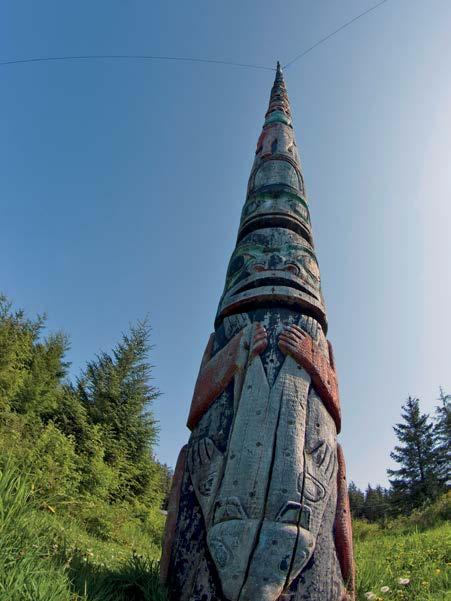
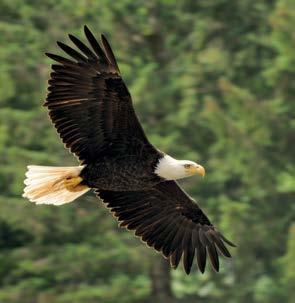
Clockwise, from far left: A totem pole at Ketchikan includes a range of different symbols and markings; the totem pole at Kake is thought to be the tallest in the world; eagles are symbolic and often portrayed on totem poles
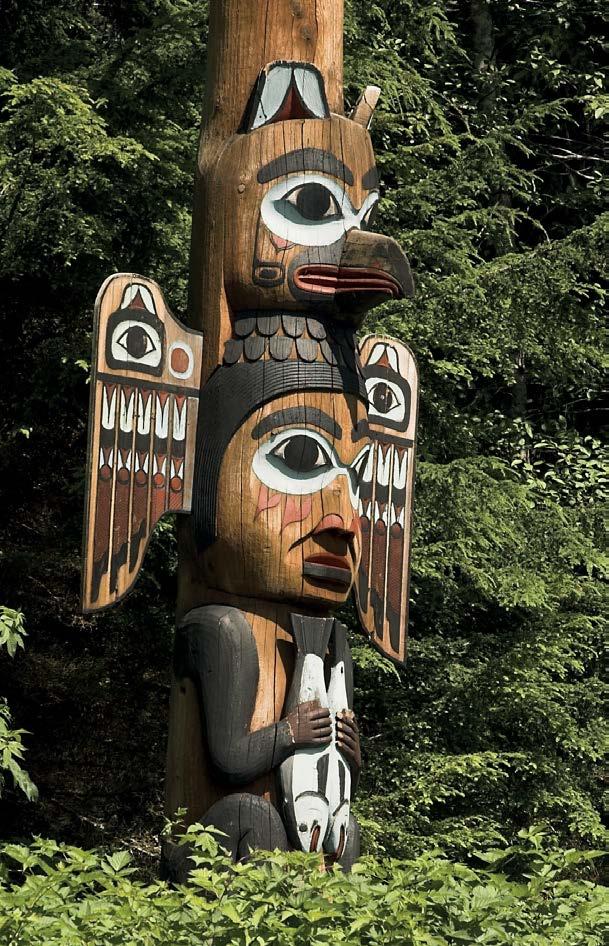
18 VIKINGCRUISES.CO.UK | SPRING 2020 harvested. A ceremony is often performed to honour the tree before it is felled, as a mark of respect and gratitude. e artists responsible for carving the tree use both traditional and modern tools to create the distinctive curves and markings, paying particular attention to the grain of the wood and any special features of the tree. Today, many totem poles which were sold or taken from First Nations communities have been repatriated as part of an ongoing e ort to maintain and promote indigenous culture. As new generations of carvers hone their remarkable skills, the tradition of carving and erecting totem poles continues, and there is no better place to go to appreciate these wonderful works of art.
The 11-day 2021 Alaska & the Inside Passage journey, from Vancouver to Seward, USA, starts from £4,840pp.
VIKING EXCURSIONS On Viking’s Alaska & the Inside Passage trip, guests are spoilt for choice when it comes to spotting totem poles. These excursions take in some of the finest examples of Alaska’s totem poles...
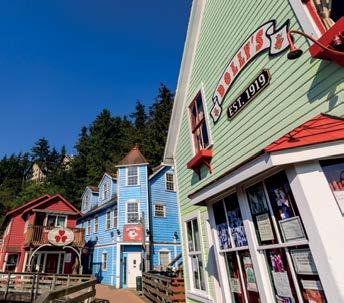
POTLATCH TOTEM PARK & KETCHIKAN HIGHLIGHTS Discover the coastal community of Ketchikan and learn about the ancient native craft of totem pole carving. Potlatch Totem Park is a modern recreation of a 19th-century native village, located on historic Tlingit fishing grounds on the shores of the Tongass Narrows. Here, you can see numerous houses, totem poles and panels, and hear the legends behind the designs. Visit the carving studio to learn about their ancient technique. After enjoying a light snack at the Alaska Totem Trading Company, you will embark on a scenic city drive through the south easternmost city in Alaska. Travel past the lively waterfront to the historic downtown area of Ketchikan, where your guide will point out highlights such as City Park, Nathan Jackson’s Thundering Wings, a totem statue in the shape of a bald eagle and the Dolly’s House Museum, located in the famous red-light district, before returning to your ship.
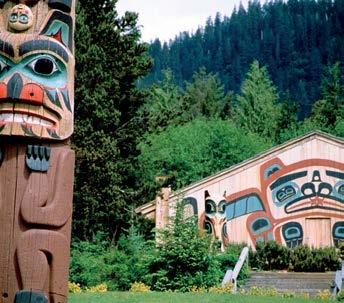
SAXMAN NATIVE VILLAGE Experience Native American culture through song, dance and stories during a visit to the Saxman Native Village. Here, you will experience the rich living culture of its residents, including the legends behind the figures adorning their majestic totem poles. You will be traditionally welcomed by Tlingit village elders with an elaborate greeting ceremony and savour an Alaskan snack. Admire their glorious folkloric regalia, adorned with hand-beaded designs of animal motifs that represent their clan. After enjoying this time-honoured tradition, visit one of the largest collections of totem poles in the world and see craftsmen passing on their skills to eager apprentices at the Village Carving Centre. Stop by the Beaver Clan House and watch history come alive as you enjoy a song-and-dance performance, and listen as your hosts regale you with heartfelt tribal stories of their traditions and ancestry.
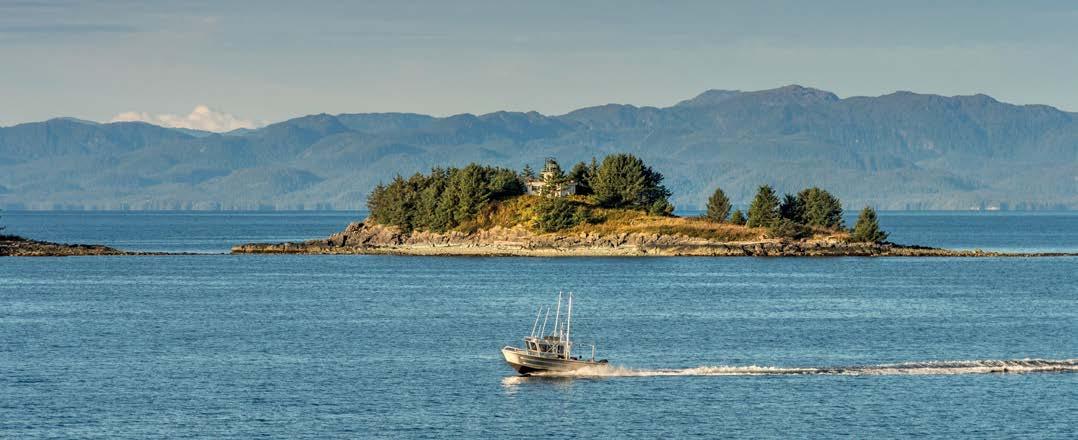

ICY STRAIGHT POINT Experience life in a Tlingit village during this fascinating excursion. The small community of Hoonah is many things to its residents: a lively fishing hamlet, an old logging town and the world’s largest Tlingit community. Its growth began with a booming canning industry, and today it is a tranquil and welcoming seaside haven adorned with native art. Walk with your guide to the Heritage Centre Native Theatre for a colourful Tribal Dance and Cultural Legends performance by local students that provides both insight into tribal traditions and a rich glimpse of long-cherished customs. Wearing authentic, vibrant regalia, Huna Tlingit performers will share their history and culture through song, dance and storytelling. You will also have an opportunity to board a tram for a drive through Hoonah to see totem poles while learning about the town’s history from an experienced guide.
Alaskan Adventures

Uncover mountain-ringed seaside towns, gleaming walls of ice and a pristine wilderness of misty fjords on this unforgettable journey to Alaska
Above: A red canoe on the shores of Davidson Lake, Alaska
DAY 1 / VANCOUVER, CANADA Embark your ship in Vancouver and marvel at the city’s scenic setting between mountains and sea.
DAY 2 / THE INSIDE PASSAGE Revel in the endless natural beauty of the Inside Passage, one of Alaska’s most scenic waterways. Verdant forest spills down steep mountains to meet the shore, bald eagles fly overhead and humpback whales breach the glass-like water.
DAY 3 / KETCHIKAN, US Alaska’s ‘first city’, Ketchikan, is home to the world’s largest collection of standing totem poles. Immerse yourself in the Tlingit legacy and legends.
DAY 4 / SITKA, US Looked over by the dramatic spectre of Mt Edgecumbe, Sitka was once the capital of Russian Alaska. Learn about the fur trade that first enticed the Russians and spot pretty islands peppered along Sitka Sound.
DAY 5 / JUNEAU, US Come to the Alaskan capital of Juneau to pan for gold in the spirit of the city’s early days, take in wonderful views from Mount Roberts Tramway or embark on a small boat ride to Mendenhall Glacier.
20 VIKINGCRUISES.CO.UK | SPRING 2020 Canadian Yukon. Today you can take a picturesque drive up to White Pass like the gold diggers of old.
DAY 7 / ICY STRAIT POINT, US Discover the old canning station at Icy Strait Point, which has been fully restored by the Native American Tlingit community from nearby Hoonah.
DAY 8 / YAKUTAT BAY Some of Alaska’s most breathtaking and pristine scenery awaits today, including majestic Yakutat Bay and gigantic Hubbard Glacier – it’s more than six miles wide where it meets the ocean.
DAY 9 / VALDEZ, US With its beautiful setting along a deep fjord in Prince William Sound, the small fishing town of Valdez never fails to impress. Excursions include a helicopter tour of Chugach Mountains and a trip to the Columbia Glacier.
DAY 10 / SEWARD, US More outdoor adventures are to be had in Seward, renowned as the starting point of the Iditarod National Historic Trail. There’s also the Kenai Fjords National Park and Exit Glacier to discover.
DAY 11 / SEWARD, US Disembark your ship and transfer to the airport.
Amazing Alaska

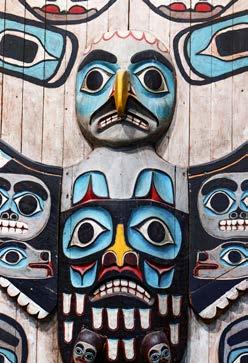
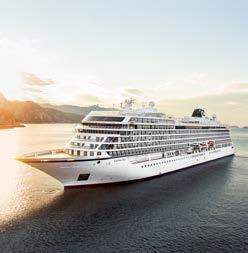
From eagles circling snow-capped mountains to whales traversing deep waters, from ice-blue glaciers the size of skyscrapers to bright red totems, Alaska is every bit as wild as you imagine it to be, and even more spectacular. As your journey unfolds, so too does the abundance of wildlife. In Alaska whales live year-round. So do bears, sea otters, sea lions and harbour seals. Of all the natural wonders, the glaciers steal the show, including Hubbard, the giant of them all. There is no better way to explore America’s Last Frontier than on board a Viking ship that offers the last word in comfort.










